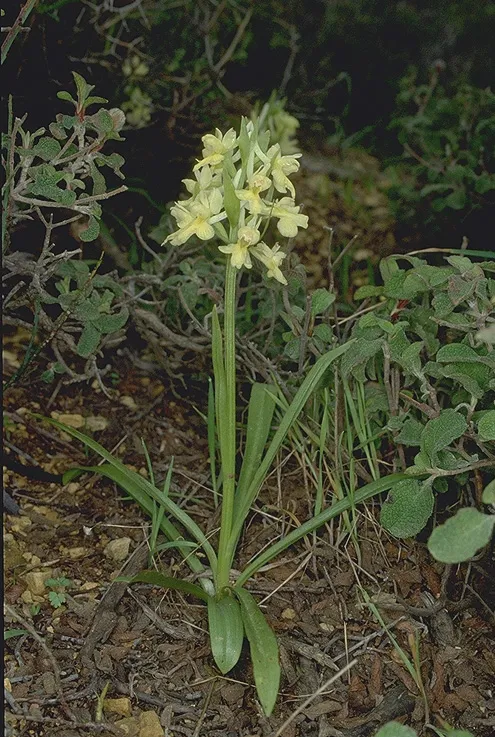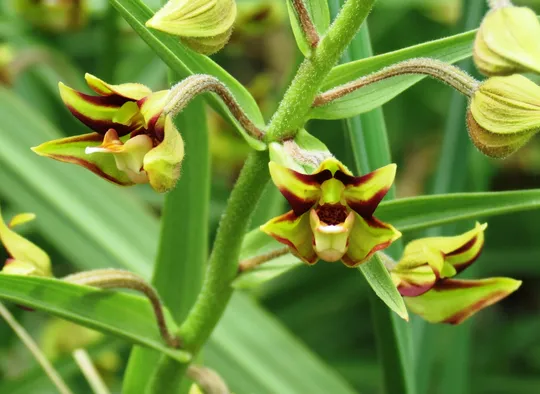Galilee Lizard Orchid, Eastern Lizard Orchid
Himantoglossum caprinum
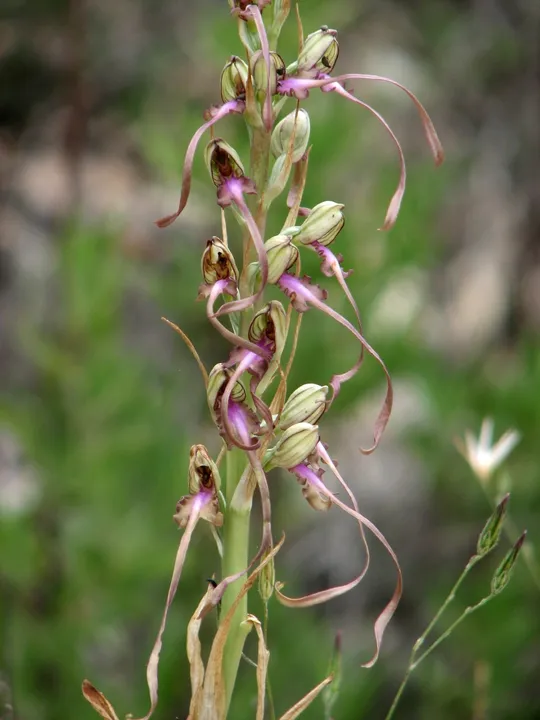
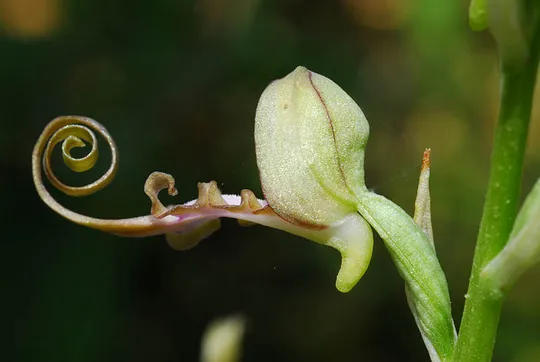

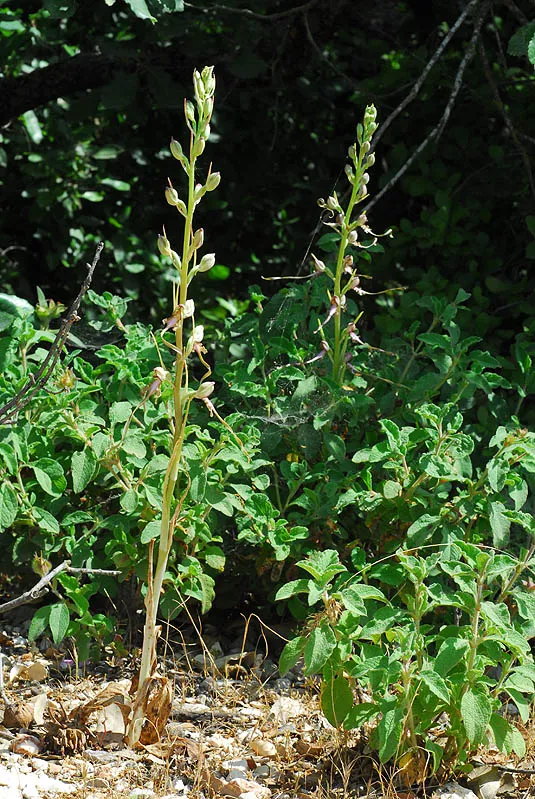
Himantoglossum caprinum grows in three regions:
the Upper Galilee, the Lower Galilee and the Golan Heights. Twelve sites in
these regions have been documented, although according to estimates there are
about 15 sites there. In the Upper Galilee there are eight sites, mostly in the
Mount Meron block, where the largest and most stable population is found. In
addition, the plant also grows on Mount Adir (extinct?) and on Mount Pu'a. In the
northern Golan Heights H. caprinum is known from
two sites in the Odem Forest and an additional site in the Mount Avital crater.
In the Lower Galilee it was found for the first time in 1986 at a single site,
near Koranit in Gush Segev.
Scrubland and
open woodland on mountains in the Mediterranean region where rainfall exceeds
600 mm, on washed terra rossa or basaltic soil.
Globally, the species is found (in a broad sense) particularly in
calcareous habitats (Iraq, Turkey). In Israel the species is apparently indifferent
to the type of soil, and it grows on soils on limestone, dolomite, chalk,
basalt and tuff.
The genus Himantoglossum
has four species that are found in Europe, North Africa and in the eastern
Mediterranean region to Iran. All the species are characterized by a sparse dispersal
pattern, small populations and large distances between populations. The genus
has some taxonomic problems: in the literature, there are disagreements about
the identity of the taxon found in Israel. According to the old guide and the Flora
Palaestina the taxon from Israel is identified as H. affine. Baumann and
Baumann
(2005) reviewed the Orchidaceae in Lebanon with
reference to Himantoglossum in Israel and their conclusion is that
the species that appears in Israel is H. caprinum ssp. levantinum. The distribution
of this subspecies includes Lebanon, Israel and Jordan and its habitat is Quercus
woodlands and garrigues on calcareous substrates (Baumann et al. 2006)
Shifman (2008)
described the plants from Israel as a new endemic species – H. galilaeum.
As there is not enough quantitative data from populations in southern Lebanon
and in view of the great variability of this species (1995, Delforge), it does
not seem justified to define the plants from Israel as an independent species.
·
Despite the
stability in number of regions (three) in which Himantoglossum caprinum grows, there is a decreasing trend in the number of sites – the
plant is probably extinct from the site on Mount Adir.
·
H. caprinum
forms extremely small populations in a highly dispersed pattern. Sometimes a
single plant is found in a large area. It also turns out that populations
appear and disappear after a few years and it is difficult to predict the
future of the populations on the known sites in Israel.
·
H. caprinum
faces a number of threats: it is attractive and in danger of having its tubers
uprooted by rare orchids enthusiasts. Also, on the Golan Heights, there is a serious
problem of plants being eaten and trampled on by cattle. In addition, the Meron
sites are damaged every few years by the development of new trails and removal
of dry wood.
·
The species
(like all species in the family Orchidaceae) is protected by law and is
included in the list of "protected natural values." The three
populations on Mount Meron, the populations on Mount Adir (extinct?) and the
sites in the Golan Heights on Mount Avital and in the Odem forest are located in
nature reserves. The other sites are located outside of reserves.
·
The taxonomic
ambiguity makes it difficult to diagnose its global threat and conservation
status.
Surveys should
be conducted to locate additional Himantoglossum caprinum
populations near the known populations on Mount Meron and the northern
Golan Heights. Demographic monitoring should be conducted in no less than two
well-known sites. Populations located on pastures should be fenced to protect
them from cattle grazing.
Himantoglossum caprinum has an eastern Mediterranean
and western Irano-Turanian distribution: from southern Turkey to northern Iraq
and western Iran, Lebanon and western Syria
Himantoglossum caprinum is a perennial geophyte
from the Orchidaceae family that has an attractive inflorescence and grows in
Israel's northern regions. The plant is rare and is found at only a few sites,
on which the number of plants is very small. It forms extremely small
populations and sometimes appears only as single plants. H. caprinum
is threatened by grazing and damage due to road construction. Its
sparse dispersal pattern is similar to that found in its global distribution.
ראה רשימת הספרות הכללית.
Current Occupancy Map
| 1000 squre meter pixel | 5000 squre meter pixel | 10000 squre meter pixel | |
|---|---|---|---|
| number of observations | 0 | 0 | 0 |
| in total pixels | 0 | 0 | 0 |
| Family | orchidaceae |
| Classification | On the endangered species list |
| Ecosystem | Mediterranean |
| Chorotype | Eastern Mediterranean |
| Conservation Site | Cedars plot below the summit trail in the Mount Meron Nature Reserve |
| Rarity |
1
2
6
|
|---|---|
| Vulnerability |
0
1
4
|
| Attractiveness |
0
2
4
|
| Endemism |
0
0
4
|
| Red number |
1
3.2
10
|
| Peripherality | N |
| IUCN category | DD EW EX LC CR EN VU NT |
| Threat Definition according to the red book | Vulnerable |
 Based on:
Based on:
